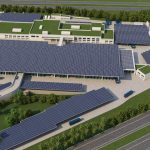Sign up for daily news updates from CleanTechnica on email. Or follow us on Google News!
Everyone is talking about a new study that makes the case for putting more floating solar arrays on existing hydropower dams instead of blocking up global water systems with a torrent of new hydropower dams. And to think, nobody had even heard about floating solar just a few years ago. Nevertheless, the floating solar field is growing quickly, and it could provide for additional grid benefits as well as ecosystem conservation, too.
Floating Solar For Hydropower Dams
To be clear, the new study does not argue against building any new hydropower plants at all. It simply observes that hundreds of new hydropower projects are on the drawing boards today. The study lays out the case for reducing that number — along with the accompanying high costs and impacts — by piggybacking floating solar panels onto existing hydropower reservoirs.
The study was produced by a team of researchers from the Department of Electronics, Information and Bioengineering at the Italian institution Politecnico Di Milano. It focuses on hydropower development in Africa, but the findings are relevant to energy systems globally.
All the details are available under the title, “Floating photovoltaics may reduce the risk of hydro-dominated energy development in Africa,” in the journal Nature. To summarize, the team reached two related conclusions.
First, regarding the amount of new hydropower that floating solar could avoid, the researchers found that amount to be significant. Depending on the circumstances, they settled on the figure of 20% displacement at the low end, meaning that many, but not most, new hydropower could be avoided. At the high end, they came up with a much more impressive, though most likely unrealistic, figure of 100% displacement.
The second issue involves the all-important issue of money, in other words does it make more sense, in terms of getting the most bang for the buck, to plow precious development dollars into new concrete infrastructure or new solar technology.
The research team reached a definitive answer on that score. “…we show that the same capital investment earmarked for planned dams in the Zambezi watercourse could be used more efficiently by building fewer reservoirs and substituting the energy supply with FPV [floating photovoltaics],” they stated.
The study also explored the impact on existing hydropower reservoirs that also have recreational, nature conservation, or cultural significance.
“Our findings suggest that FPV’s potential to avoid the environmental, social and financial risks of hydro-dominated energy development may outweigh its potential impacts on existing reservoir uses,” they concluded.
Everybody Loves Floating Solar
The new study supports other research work around the world, including a 2020 report on the benefits of adding solar to hydropower dams in Brazil issued by the US Department of Energy’s National Renewable Energy Laboratory.
Back then, the idea of staging a solar array on a hydropower reservoir was still a new idea. As of 2020, the only such installation that NREL spotted was a relatively small one, located in Portugal.
Floating solar was still a new field at the time, and pairing it with hydropower seemed like a daunting task challenge. Solar panels on a hydropower reservoir have to be waterproofed and storm-proofed. In addition, their supporting and mooring structures also need to address changes in water levels, from daily to seasonal cycles. Deep water and steeply sloping walls can present additional obstacles.
Challenges or not, the idea began to catch on. In 2022, EDP Renewables launched the biggest floating solar farm in Europe on a hydropower reservoir, located at the Alqueva hydropower plant in Portugal. It weighed in at only 5 megawatts, but it was a start.
And how. Last year CleanTechnica took note of project under way in Indonesia at the Circata hydropower reservoir, aimed at a potential of 500 megawatts.
More Benefits From Floating Solar + Hydropower
Aside from the clean kilowatts themselves, researchers have assembled a laundry list of other benefits for hydropower-plus-solar projects.
Reducing evaporation and shielding the aquatic ecosystem from an overabundance of sunshine are two important side benefits. Since hydropower plants are already equipped with transmission lines, the need for new transmission infrastructure is also minimized.
The Politecnico Di Milano team further notes that the solar panels can balance out seasonal variations in hydropower output, resulting in a more steady, reliable supply of electricity in hot, dry weather.
The solar-hydro combo “yields an energy output 12% less variable and more robust to long-term hydrological changes,” the researchers note.
NREL took that factor into account when it compiled a report taking stock global solar-plus-hydropower potential.
Issued in 2020, the NREL report took a look at 379,068 existing hydropower reservoirs around the world and estimated a potential output of up to 10,600 terawatt-hours of electricity with floating solar. That’s in addition to the electricity generated from hydropower turbines.
“For comparison, global final electricity consumption was just over 22,300 terawatt-hours in 2018,” NREL noted.
Next Steps For Hydropower + Solar (Plus Pumped Hydropower)
Before you get too excited, NREL emphasized that the figure of 379,068 includes reservoirs that could be dry for part of the year, or that are otherwise unsuitable for floating solar panels.
Still, if even a fraction of the existing hydropower plants could be put to use generating solar energy, that would provide significant benefits to local jurisdictions in terms of avoiding excessive infrastructure costs while preserving social, environmental, and cultural assets.
In an interesting twist, NREL also suggests that pumped hydropower energy storage could come into play.
Pumped hydropower is not a new technology. It is already the biggest single form of utility-scale energy storage in the US, accounting for 95% of the available capacity. In fact, pumped systems are so old that utilities can add significant new capacity just by replacing their old turbines with new, more efficient technology.
Under a renewable energy scenario, pumped hydropower deploys excess wind or solar power to raise water to a reservoir located at a higher elevation. Gravity does the rest of the work. When more electricity is needed, the water runs downhill to a generating station. After that, the water can be shunted into a river or recycled back to the upper reservoir in a closed loop system
If you’re thinking that putting solar panels on the upper reservoir in a pumped storage system would be a good idea, well, maybe. However, that can be especially challenging because the water level can drop drastically, and frequently.
Pumped hydro is not the only form of energy storage that can be attached to a hydropower project. We’ll be keeping an eye on Thailand, where EGAT (the Electricity Generating Authority of Thailand) has laid plans for floating solar at more than a dozen different hydropower dams, including energy storage features.
Follow me @tinamcasey on Bluesky, Threads, Instagram, and LinkedIn.
Image: Photovoltaic arrays paired with hydropower dams (courtesy of US DOE).
Have a tip for CleanTechnica? Want to advertise? Want to suggest a guest for our CleanTech Talk podcast? Contact us here.
Latest CleanTechnica.TV Videos
[embedded content]
CleanTechnica uses affiliate links. See our policy here.
This post was originally published on 3rd party site mentioned in the title of this site






